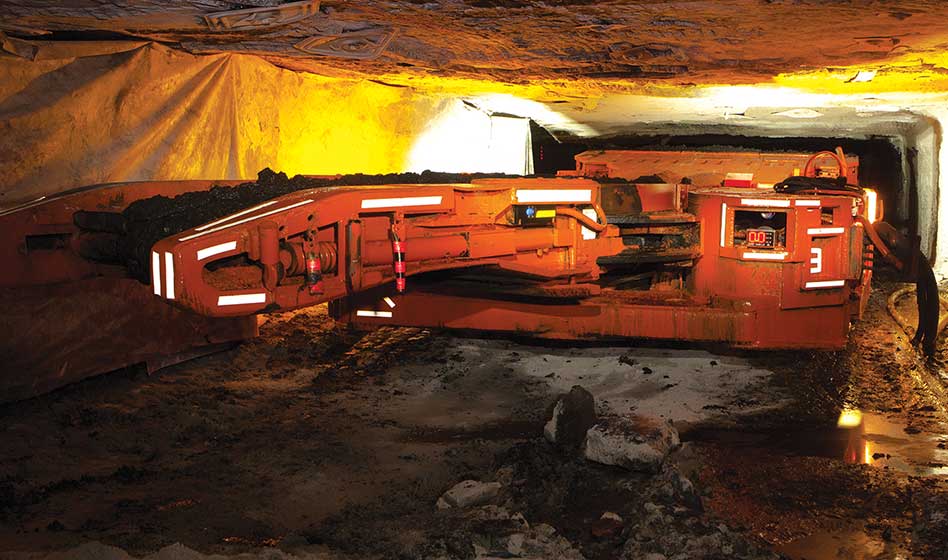
The 140B is in high demand after a rival supplier pulled a methane monitor from the market. (Photo: CSE Corp.)
Demand is shifting to existing and new gas monitoring solutions that are versatile and offer cost savings
By Jesse Morton, Technical Writer
The exit of a methane monitor from the market has shifted demand to existing and new offerings that suppliers say will help an operation meet regulations and ensure the safety of personnel. Among the offerings that could see growing demand is a long-established machine-mounted system widely deployed for its ease of use. A new wireless solution for use at the face is set to be released. Three new pocketable solutions with wireless data transmission capability offer levels of alarms. And a system commonly used on longwalls is seeing demand for its cost-effectiveness. Suppliers say that each is rugged and reliable, and empowers the user with options.
Proven Monitor Offers Reliability, Accuracy
CSE Corp. said the 140B Methane Monitor has seen high demand over the last 18 months. “Right now, there has actually been a major supplier that has withdrawn their machine-mounted methane system from the marketplace,” said Scott Shearer, Jr., director of special projects.
Customers “have very quickly needed to shift, and our team has been there to support them throughout that rapid change, from getting them set up with the systems that they need, the training and support, and making sure we have enough parts and inventory,” he said. “But I think it is one of the things that our team excels at is on the support side, where, anytime of day, our field team can be out there to help with installations and general support and training.”
The 140B is comprised of three components. The “detector head is going to be up by the mining face where you are going to be detecting the methane or the potential for methane,” Shearer said. “You are going to have your power supply, and you are going to have your control unit,” he said. “It is one of the benefits of the system that it is quite simple in its design, and that helps with its ruggedness.”
The design employs “a catalytic bead-type of methane detection. It is an incredibly reliable and robust detector,” Shearer said. “Obviously there are a lot of environmental conditions thrown at this up at the mining face,” he said. “It has a long track record of being reliable and highly accurate, including with higher levels of methane. It can withstand anything thrown at it.”
The 140B can be arranged in either a single- or dual-detector setup. “It can also have a single display or an additional auxiliary display on the machine,” Shearer said. “Depending on what they want, we can offer a few different variations of the system to increase safety and also visibility of the displays.”
Alarm thresholds “are obviously confined by regulations, but then some operators want them to be slightly different,” he said. “They want it on a more conservative level. We can help set the alarm points for them.”
The topmost feature of the solution is its accuracy. “You want to be able to trust the system when it tells you that there is a problem that it just found, and our system does just that,” Shearer said. “It keeps you running when you are in safe operating limits and it is appropriately shutting down when there are limits that are exceeded,” he said. “The combination of unbroken uptime, a safer working environment, and fewer citations will be attractive to any kind of investors or operation.”
Unbroken uptime translates into increased productivity. “Obviously, miners are there to mine, and if you are fighting issues and troubleshooting equipment you are not mining,” Shearer said. “We want to make sure that they are operating as much and as safely as they can.”
Customers love the 140B because they can set it and forget it. “You don’t put much thought into it because it just tends to be there working in the background,” Shearer said. “But what an important piece of equipment it is to keeping miners safe. It really does make a difference.”
The 140B can be stalled in advance on new equipment. “We work with some of the largest OEMs of mining machinery,” Shearer said. “We take equipment specifications ahead of time and we can help schedule and have personnel guide them on an installation and get them running and operational,” he said. “The last bit to do on an installation is training the team.”
Training is offered for maintenance personnel, electricians, foremen, and safety department personnel. “Each operation is a little bit different but we don’t limit on the training side,” Shearer said. “We really do see a very strong correlation with uptime and training,” he said. “It is simple to maintain as long as you have people who continue to maintain their training and understanding of the system.”
The history of the 140B traces back to the origin of the company in the late 1960s. “It is a testament to just how strong a product and a product design it is that it has continued to serve industry this long,” Shearer said. “We’ve had people leave and go and try other products and the vast majority end up coming back, saying, ‘I wish I didn’t do that,’ and ending up putting the 140B back on their machine.”
Potential customers looking to switch to the 140B, “as long as they reach out to us, we can make the process as easy as they would like,” he said.
“By getting personnel in front of them, we can help them assess the situation and what needs they have,” Shearer said. “And then we can help them understand how the system would fit their application in terms of some of the configurations and rules and regulations depending on the state and various requirements that are needed.” An installation can be coordinated to coincide with routine maintenance. “That kind of schedule timing really helps and is a key consideration.”
The 140B is made in the U.S., which enables the company to better respond to orders and arrange deployments. “The whole system, not just the sensor, is made here in our facility just east of Pittsburgh,” Shearer said. “We are one of the few that really manufacture the actual detector head.”
If the unit does malfunction, the company offers a repair-exchange program for the components. “If and when something does break, they can easily swap it out with parts that we have,” Shearer said.
“We know that has been a common complaint about some of our competitors is the difficulty in getting parts and responses quickly,” he said. “We make sure that there is full support, not only with personnel but that we have a robust inventory to respond when something eventually does wear out.”
New Wireless Monitor for the Face
Conspec Controls announced the imminent release of the MSHA-approved Wireless Optio G Monitor for integration into its hybrid atmospheric monitoring networks. Supported by one of the company’s new gateways, the unit can be deployed at the face, leadership at the supplier said.
“It allows you to get the most of your atmospheric-monitoring system (AMS) by venturing into hard-to-reach areas for the network using our wireless hybrid approach and ensuring gas monitoring is being done in all areas of the mine,” said Tanveer Jahir, B.Eng, P.Eng, international business development manager, Conspec Controls.
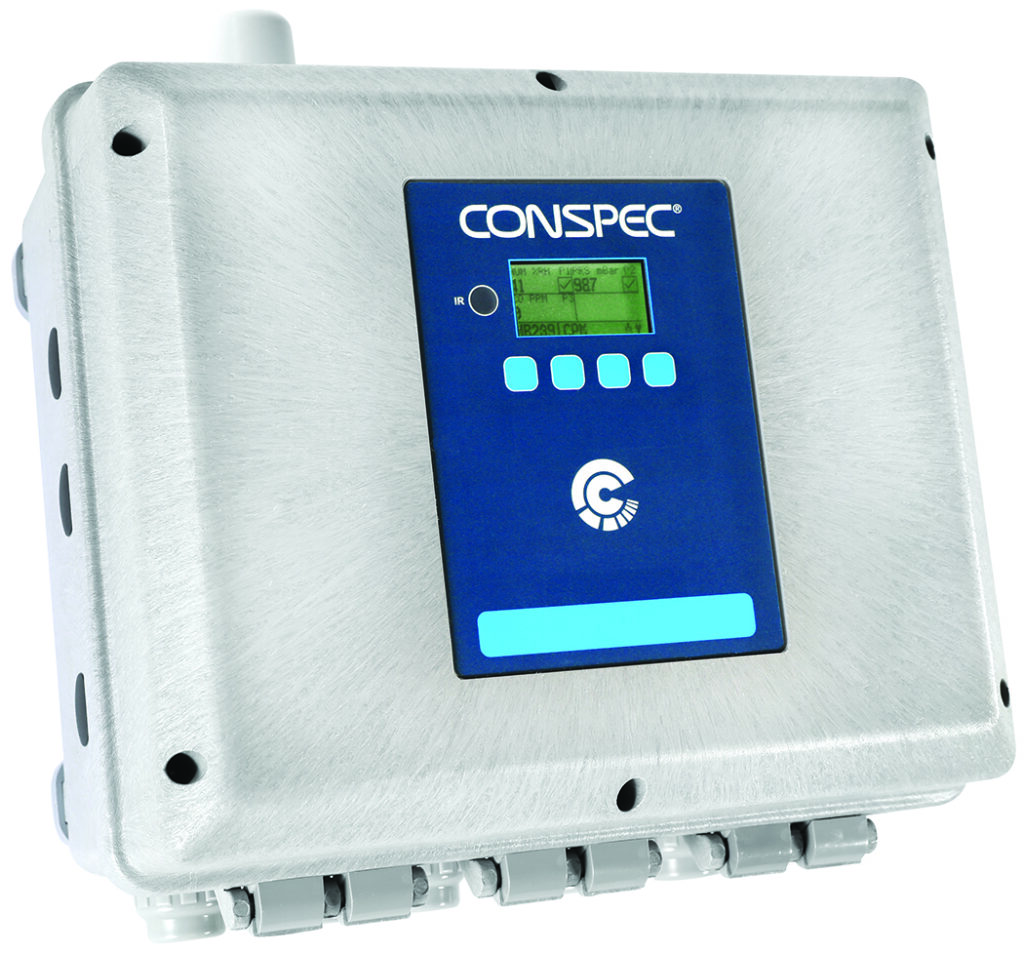
The Wireless Optio G Monitor offers wireless atmospheric monitoring at the face. (Photo: Conspec Controls)
The wireless hybrid approach uses newly released gateways that can be installed on a cable network to talk to the Wireless Optio G Monitors. The gateway is installed at the far end of the cable, “and from that point onward, the wireless methane monitors would be used,” he said. “Our gateways take care of the polling to the wireless gas monitors, and ensure that you have a strong dependable backbone, the cable network, to quickly and reliably send the data to the surface.”
The wireless monitors can be deployed at the face “where a lot of the dangers of methane and other toxic and explosive gasses exist,” Jahir said. The front-end software “sees the wireless unit as if it was wired, seamlessly.”
Seamlessly monitoring gas values “at the face, and having that data forwarded to a front-end system on the surface in real time, provides a level of enhanced safety not previously available with cabled networks,” Jahir said.
The solutions offer flexibility and scalability for building out an AMS at the pace of production. “The Optio platform offers more flexibility than any other design on the market,” he said.
“We understand that your mine is unique, so should your AMS be,” he said. “The Optio platform offers a wide range of different gas and environmental sensor support, and various communications support.”
Each monitor supports up to six sensors, offering “a nice way to scale your sensor needs,” he said. “You get what you need today, and each monitor implicitly has the capability to expand, giving you that added advantage of additional sensors as you need them in the future.”
Currently, wireless solutions by the supplier are routinely adopted for use at the face, he said. They allow the customer “to get as close to the action as possible and to really see what the atmospheric conditions are near the blasting face,” Jahir said. “Many of our coal clients in Mexico are looking into not only measuring the methane levels at the face using our wireless gas monitors, but also using it to automatically shutdown their continuous miners if methane is being detected.”
Optio solutions trace their history back well over a decade. “The platform was developed to take into account all the lessons we learned over the past 5 decades,” Jahir said. “It not only has products for the coal mining market, it also has oil and gas, industrial, and commercial HVAC product offerings,” he said. “Over the years, the monitor has been fine-tuned into the robust, cost-effective solution you see today.”
It is simple to install, manage and maintain, and can be used as a stepping stone to a future wireless system.
“We all understand that wireless technology is the future,” Jahir said. “But we also understand the caution that the mining industry uses in exploring new technologies, especially in coal mining,” he said. “Being able to provide a solution that gives you the best of the future, as well as continuing to use the systems of the past, gives the perfect middle ground from which coal mines can take that wireless leap.”
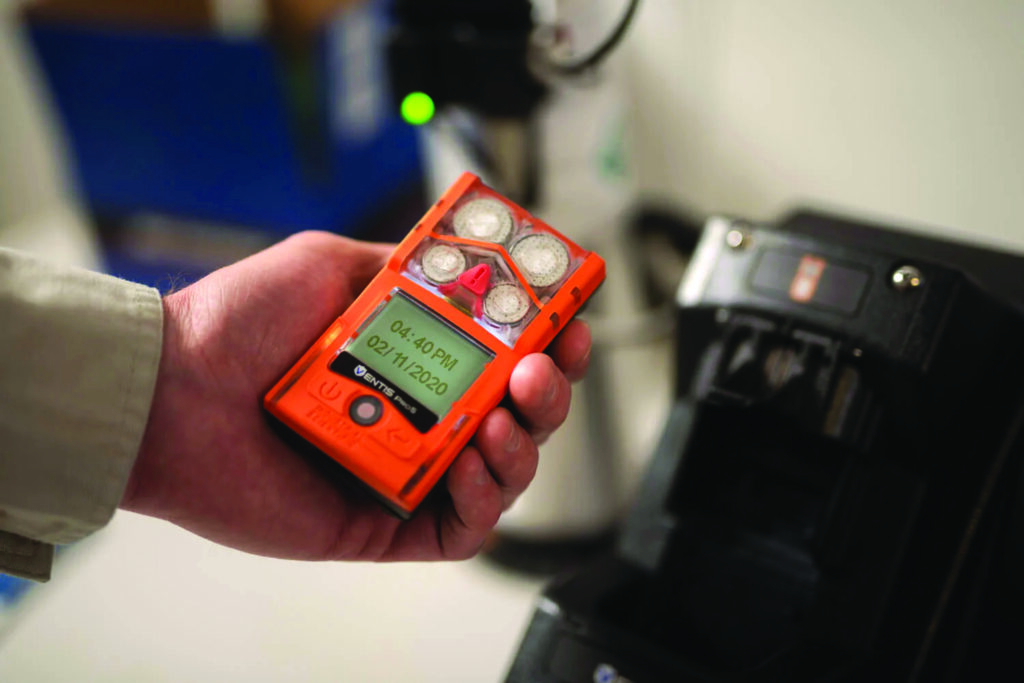
The new Ventis Pro monitor offers man-down and panic-alarm capability. It features the LENS wireless system for transmitting data. (Photo: Industrial Scientific)
Pocketable Monitor for Remote Readings
Industrial Scientific reported seeing demand for the new Ventis Pro monitor with LENS wireless technology. “A number of mines are beginning to adopt the monitor and the technology to capture face methane readings in the deep-cut applications,” said Dave Wagner, director, applications engineering and field services.
The unit “is a typical multi-gas monitor used to detect methane and other gases,” he said. “It incorporates a 2.4-GHz mesh radio system that allows monitors to communicate with each other and share readings and alarms within a local network.”
Beyond gas-detection capabilities, “Ventis Pro offers man-down and panic alarm capability along with the LENS wireless system that allows those alarms to be communicated with other monitors,” Wagner said. “The Ventis Pro can also connect to a WIFI network to have readings and data communicated remotely to the surface on a mine’s pervasive WIFI network.”
The data can be used to make timely changes to optimize safety and processes. “In a number of ways, the remote monitoring capabilities allow operators to monitor conditions that the workers are in and exposed to,” he said. “It helps get a clearer picture and understanding of the conditions in the mine at all times, giving them opportunities to make corrective actions.”
Corrective actions driven by data improves both the safety an confidence of workers.
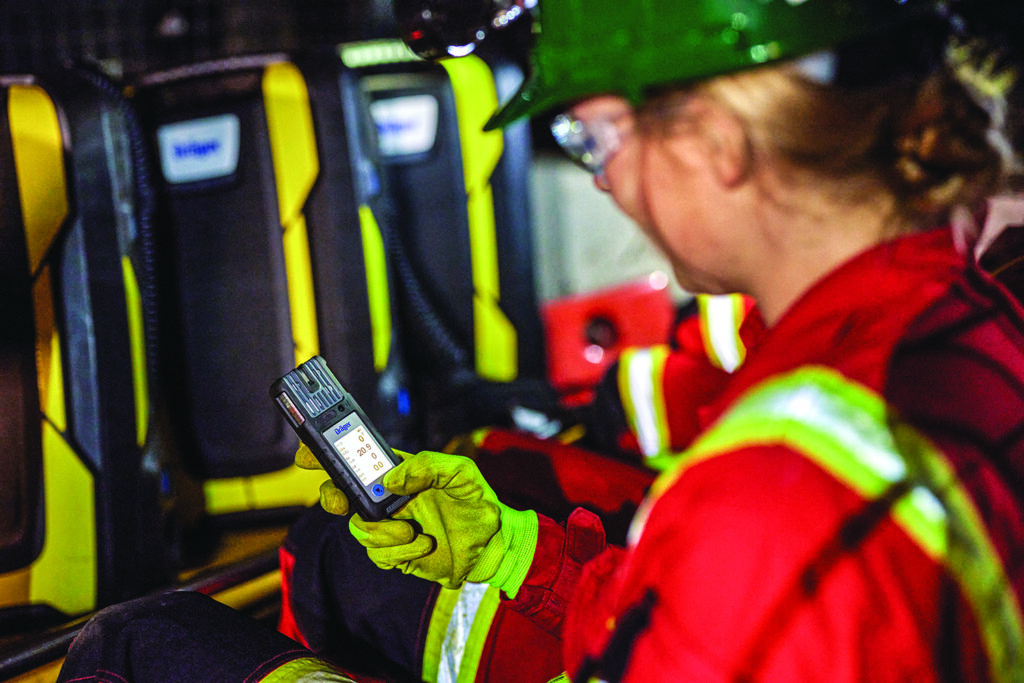 “The peer-to-peer communication technology gives miners working underground the assurance that other members of their team are always aware of their conditions and are always watching their back,” Wagner said.
“The peer-to-peer communication technology gives miners working underground the assurance that other members of their team are always aware of their conditions and are always watching their back,” Wagner said.
The monitor can be used to streamline some menial tasks.
“In particular, the ability to share readings between monitors provides a solution to a long-term problem of having to perform the required 20-minute methane checks at the mine face that requires reading the display on a monitor up to 40 feet away,” he said. “The Ventis Pro gives you the ability to have a monitor at the working face, capture the methane readings, and display them on a second monitor that the miner is holding over 40-feet away.”
The solution originally arose from a public-private partnership. “The LENS wireless system, originally known as the Whisper system, was a collaboration between engineers at Industrial Scientific and a local university,” Wagner said.
“The concept relied on the belief that there was value in workers on a team being able to share information from their monitor with each other,” he said. “After initial development the key milestones were actual testing in heavy industrial environments and then of course underground to prove the concept would work, and then achieving MSHA certification of the monitor with the wireless system.”
Pocketable Monitor With Three Alarms
Dräger said the new X-am 5800 and 2800 gas monitors are certified in Europe and North America by CSA and will be submitted for MSHA approval.
Currently, the two feature a standard catalytic combustible sensor that offers an abbreviated warm-up time. “Basically one minute from the time you turn the instrument on it can be calibrated, whereas older instruments require 3-plus minutes before you can calibrate,” said Russell Warn, senior product support manager, Emergency and Rescue Services. The new models currently detect up to five gases.
Dräger will also submit to MSHA a new infrared (IR) sensor that will be built into the units “that will enable them to do the full range of methane from 0 up to 100% by volume,” he said. “It will not only take care of personal safety-type applications, it would take care of the seal testing that is done in underground mining and also the rescue chamber.”
A micro-electromechanical system, the new IR sensor is small and has a run time of more than 100 hours, making it unique for rescue chamber applications. “It is very durable, very low power,” Warn said. It has a battery-powered attachable pump. “It will give us a lot of opportunity because we will have a smaller monitor than what is out there.”
Dräger has developed “three versions of the IR sensor,” he said. “One is strictly for carbon dioxide, one strictly for combustible gases including methane, and one that is a dual sensor that will do both combustible gases and CO2.”
With the new dual-IR sensor, the X-am 5800 will be capable of up to six gas configurations. “We have some dual electrochemical sensors for CO and H2S, for O2 and CO, for O2 and H2S, and then individual sensors for an array of other gases,” he said. “We’ve got quite a bit of flexibility in a very small instrument.”
Both the X-am 5800 and 2800 are compact with a broad exposure area for the sensors. “The sensor grid is designed so the gas can get in from the front of the device or it can get in from the top so that if you happen to put it in a pocket you don’t potentially smother it and block gas from getting into the sensor,” Warn said.
X-am Series monitors have a simple, intuitive design. “Most of our instruments have two buttons,” he said. “It is one button on, two buttons off, get out if it starts to beep.”
Both new units “have Bluetooth capabilities so that we can communicate with other Bluetooth devices and our Gas Detection Connect system,” Warn said. They can be supported by an LTE network.
“We also are working with other system integrators so that third parties could take our instrument and easily integrate it into their system depending on what is needed,” he said. “Even our new rebreather unit, our new Dräger BG ProAir, may have Bluetooth capabilities so that our monitors could connect directly to it.”
Both monitors have “three levels of alarm,” Warn said. “We have the low alarm level, which is typically for combustible gases, combustible gas sensor set at 10% LEL, and then a higher alarm at 20%,” he said. “Basically when you get an alarm, ok it is time to leave. When you get a higher alarm, maybe it is time to leave a little faster.”
The monitors are durable, and come with a 4-year warranty on the device with a 5-year warranty on the standard O2, CO, and H2S sensors. The IR sensors will also carry a 5-year warranty. “We’ve got steel industry customers that are using instruments that are literally 10-plus years old that still work fine,” Warn said. “A sensor goes bad, they can replace a sensor. They can replace the battery pack when it goes bad. They just keep working. For customers, that’s great,” he said. “When you are trying to sell new product, sometimes that is a roadblock.”
Dräger tests new products using a process inspired by testing done on thermal imaging cameras for NFPA (National Fire Protection Association) approval. “In this test they have basically a 4-ft-dia. hamster wheel,” Warn said.
“It is turned on and the hamster wheel turns at 15 rpms and that instrument is in that hamster wheel bouncing around for about an hour,” he said. “At the end of that hour, when you take the instrument out, it still has to be working and it still has to pass a functional test in order to be ok.”
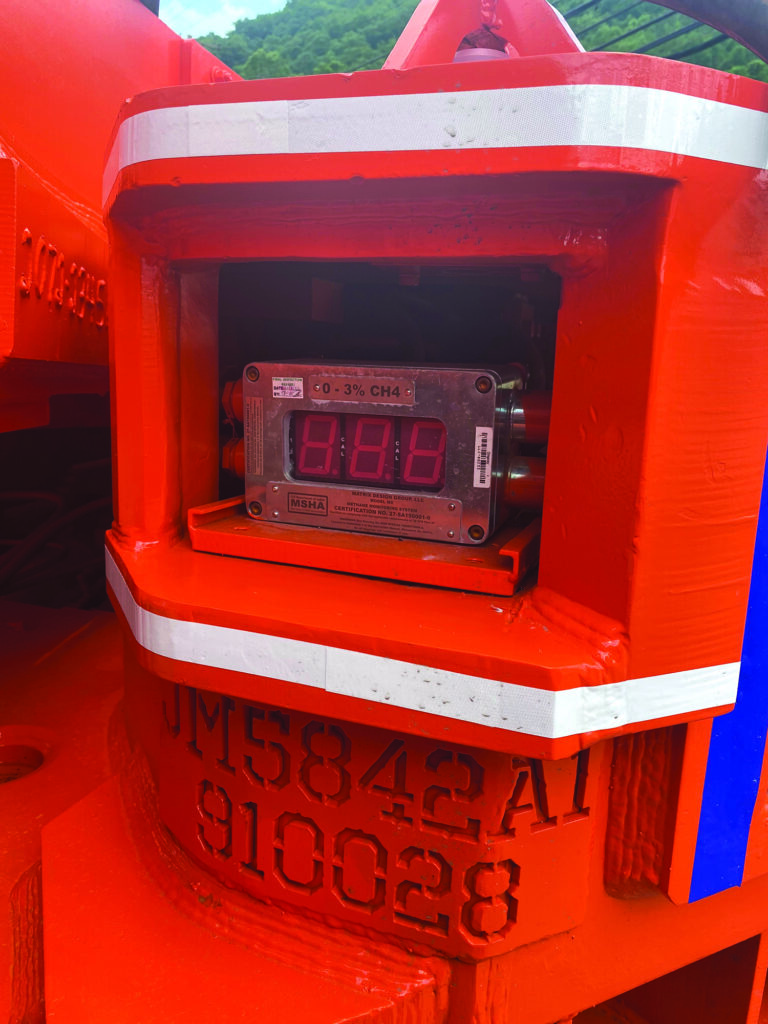
The Matrix M5 has a large, easy-to-read display screen. (Photo: Matrix Group)
The X-am series launched more than a decade ago with the X-am 2000, 1700, 1000, and 5000. “Then the X-Am 2500 came out a little after. The X-Am 2800 was released early last year. The X-Am 5800 launched over the summer. The two new models “use the same body and a lot of internal components,” Warn said.
The company’s history of developing IR sensors goes back more than two decades. Predecessor IR sensors had roughly 10 hours of runtime. “We upgraded so it is more stable,” he said. “This one will be even more durable, using less power, and still do everything we need it to do.”
Rugged Monitor Stays Accurate
Matrix Group reported sustained demand for the Matrix M5.
“The Matrix M5 machine-mounted methane monitor is now being implemented in the longwall market by multiple new customers across the U.S.,” said Chris Adkins, mining manager.
The system’s popularity is due to capabilities that distinguish it from competitor solutions, he said. “Both the CM and longwall markets have shifted in large part to the M5 over the last three years because of its water-resistance and zero-drift capability.”
The Matrix M5 offers efficiency gains that can translate into cost savings. “Its ability to use two sensors with one read-out is cost effective,” Adkins said. “Mines don’t have to buy multiple systems,” he said. “Additionally, the M5 has a manufacturer’s factory override that allows certain system faults to be bypassed for maintenance purposes.”
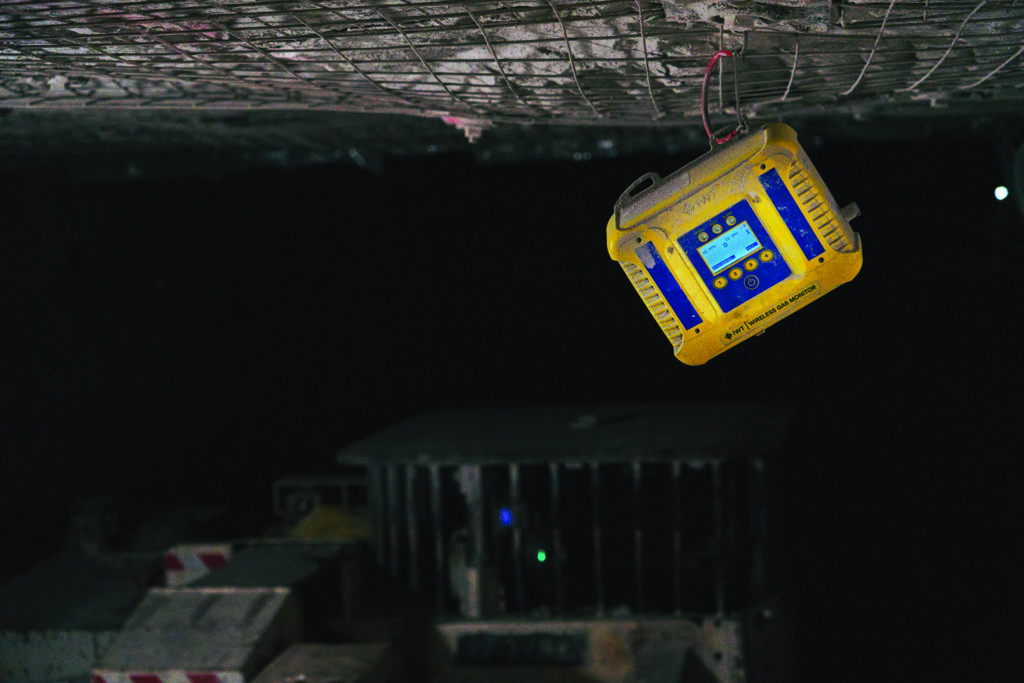
A Sentinel wireless gas monitor like the above transmits gas levels, temperature, pressure, and humidity. (Photo: IWT)
Cut the Cord on Methane Monitoring
By Chad Barnett
The ability for mine personnel to effectively monitor for toxic and combustible gases is critical to the health and safety of miners working in underground coal mines. Having the equipment and systems in place to detect methane quickly and accurately, is imperative. The most advanced methane-monitoring systems on the market are now wireless.
Methane is colorless and odorless, making it difficult to detect without specialized equipment. The use of machine-mounted methane monitors is required by federal regulations to alert miners to the presence of potentially dangerous concentrations of methane. Regulation 30 CFR Part 75.342 mandates that all mechanized equipment used to extract or load coal within the working section must have MSHA-approved methane monitors installed to provide continuous readings of methane levels.
The monitors should be installed as close to the working face as possible. In fact, proper placement of the methane monitor on the mining machine is one of the most important factors in accurately measuring methane levels. Further, the response time of the methane monitor is critical because while the mining machine is cutting coal, methane levels can rise and fall rapidly, and miners must be able to respond quickly.
In addition to machine-mounted methane monitors, a network of gas monitors installed throughout the mine allows for continuous monitoring and collection of atmospheric data. Many underground coal mines also monitor in areas of the mine where workers are not generally located. Constant monitoring of remote and abandoned underground areas would be impracitcal with wired systems.
Wireless systems that offer methane monitoring provide several benefits for mine operators, and can increase safety and productivity as well as reduce the overall cost of owning the system. There are many considerations when selecting a methane-monitoring system, such as ease of use, installation and maintenance cost, detection accuracy, the ability to meet applicable regulations, and overall system performance.
Measured gas readings as well as any event notifications can be transmitted wirelessly through the network to a dispatch station at the surface. Also, as a coal mine advances, wireless systems can easily be moved as needed.
Precision Sensor Technology
Wireless systems can use advanced sensors to detect even small amounts of methane gas. They can provide more accurate readings than traditional wired systems. One type of advanced sensor technology available today is non-dispersive infrared (NDIR) gas sensors. These sensors are a type of optical gas sensor that uses the principle of IR absorption to detect and measure the concentration of specific gases in the air.
These sensors primarily consist of an IR light source, a gas sample chamber, an IR detector, and a signal processing unit. The methane is exposed to the IR light, and the amount of light absorbed is used to determine the concentration of the gas in the sample chamber.
There are several advantages of using NDIR gas-sensor technology. NDIR sensors can detect specific gases at low concentrations, even in the presence of other gases, providing accurate and reliable measurements. The performance of NDIR sensors remains stable over time, with minimal drift and calibration requirements, making them suitable for long-term monitoring applications. NDIR sensors are less affected by contaminants and interfering gases, providing accurate measurements in the harshest environments.
There are several wireless gas monitors with precise sensor options available in the market today. These enable mine operators to maximize the health, safety, and productivity of workers underground.
One example, the Sentinel wireless gas monitor from Innovative Wireless Technologies (IWT), is a battery-powered device with a built-in wireless transceiver and replaceable sensor module that allows monitoring of up to four gases with a single device. The WGM operates seamlessly with the IWT wireless network, the Sentinel communications and tracking system.
With the Sentinel system, gas-sensor readings are displayed locally at the device and transmitted wirelessly over the network to a dispatch station aboveground. Event notifications are also displayed locally on the device, aboveground at the dispatch station, sent to users with Sentinel handset radios, as well as to an audible/visual section alarm. They are NRTL- and MSHA-approved, provide battery life up to 6 months, and use NDIR gas sensors featuring ease of calibration and high performance for methane detection.
Methane monitoring is critical to the health and safety of underground miners. Since methane is highly explosive and continuously released during mining operations, it can accumulate in poor-ventilation areas and, if ignited, cause explosions that can injure and kill. Therefore, it is crucial for mine operators to have adequate equipment and systems in place to detect methane quickly, effectively, and accurately to protect miner health and safety.
Chad Barnett is the product manager for IWT.



